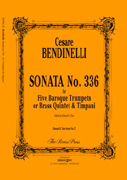Bendinelli, Cesare (Tarr) Sonata No 336, from Tutta l'Arte della Trombetta (1614)
Trumpet Quintets w/Percussion

-
Bendinelli, Cesare (Tarr)
Sonata No 336, from Tutta l'Arte della Trombetta (1614) (Tarr) [500.00 or 211.01 w/timpani]
Cesare Bendinelli. 1542-1617. For five baroque trumpets or standard brass quintet [211.01]. Optional tympani part included.Cesare Bendinelli, who was probably born around 1542, served as a trumpeter at the court of Vienna and was then chief trumpeter ("Obrister Trommeter") at the Munich court from 1580 until his death in 1617. His manuscript trumpet method of 1614, Tutta L 'arte della Trombetta (facsimile published by Editions Bim) is the earliest trumpet method now known. (For further biographical information on Bendinelli, please see the editor's article in Brass Bulletin 14, 1976.) The main contents of Bendinelli's methods are 332 so-called sonatas, which were intended to be played by a five-part trumpet ensemble. At the beginning of that section of his method, Bendinelli laid down the rules for improvising in such an ensemble. Only the second part, which he calledthe "sonata" part (as opposed to Monteverdi's "Quinta"), was notated, and indeed furnished the foundation for the collective improvisation. The player of the clarino part improvised certain flourishes in the lower part of the fourth octave of the harmonic series, and examples of clarino writing were given in No. 333 of the method. The players of the fourth and fifth parts, as with Monteverdi, confined themselves to a single note each, g and e respectively. The player of the third part ("alto e basso") was supposed to be quite expert in imitating exactly the notes of the sonata part one step lower in the harmonic series. The result of this kind of improvisation, as opposed to Monteverdi's overlapping, was a rather block-like effect. The last three sonatas of Bendinelli's method, Nos. 334-336, contain both the clarino and the sonata parts. For this edition the editor has reconstructed the lower parts. This is the kind of music trumpeters played in the late sixteenth century at the great courts to solemnify the activities of their sovereigns. -the publisher
-
- Category: Trumpet Quintets w/Percussion
- Item: 036900
- Grade/Level:
- Price: $25.95
-
(usually ships in 10 to 15 days)
